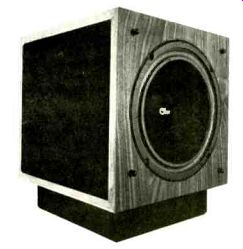
AVERAGE OMNIDIRECTIONAL OUTPUT 132 to 140 Hzl 76 dB SPL for 0 dBW 11 watt) Input
CONTINUOUS ON-AXIS OUTPUT lat 85 Hzl 91 dB SPL for 10 dBW 110 watts) input
"NOMINAL" IMPEDANCE 3.5 ohms
Ohm Model N subwoofer system in walnut-veneer cabinet.
Dimensions: 16 1/2 by 18 inches (front, 16 inches deep plus clearance for controls and connections.
Price: $320 optional Model M satellite speakers, $1451.
Warranty: "limited," five years parts and labor.
Manufacturer: Ohm Acoustics Corp., 241 Taaffee Place, Brooklyn, N.Y. 11205.
The Ohm N subwoofer represents one aspect of the burgeoning field of low-bass extenders: subwoofers designed to operate in concert with limited-range mini-speaker satellites. Although Ohm offers a complete system (the N plus two Model M satellites), the subwoofer is sold separately to enhance any brand of mini-speaker.
Due to the omnidirectional dispersion of low frequencies, placement is not critical, and for those who see the mini/subwoofer combination as a way to avoid losing too much floor space to large speakers, the low-standing, cube-shaped N will fit inconspicuously just about anywhere.
The N's driver complement consists of two 8-inch woofers, mounted front and back and acoustically coupled to two 12-inch passive radiators. Ohm claims that response reaches down to 32 Hz. Though maximum output in the CBS anechoic chamber occurs at about 70 Hz, rolloff below this point is not particularly steep-even without the reinforcement provided by normal floor placement. A built-in passive crossover network cuts in at 140 Hz, and Ohm states chat very little will be gained by opting for an outboard electronic crossover. Two pairs of spring-loaded clips connect the N to an amplifier's output, and two more link the output to the satellites. A single three-position satellite-output attenuator is the only control on the N. Ohm recommends a minimum of 10 and maximum of 100 watts ( I 0 to 20 dBW) to power a complete subwoofer/satellite system. The output data show that the N reaches 91 dB of output for only 10 dB of input (at which point, in the 85-Hz test, buzzing begins). In actual use, of course, the crossover network would shunt most of the musical energy (that above 140 Hz) to the satellite speakers, so the recommendation seems reasonable and the N's output an adequate match for most minis. Efficiency, too, seems reasonable for this purpose. And since impedance is low (between 3.5 and 8 ohms throughout the subwoofer's working frequency range), the N makes the most of the amp's power capabilities.
Trying to judge the subjective difference a subwoofer makes to a good pair of full-range loudspeakers is difficult. The plain truth is that there is not enough low bass on most records to provide a comparison. With typical minis (we used Ohm's own satellites), however, the improvement in bass reproduction can be startling. The N supplies a clean, well-defined bottom end with no apparent boom. At the 0-dBW level, second harmonic distortion is very low--generally below 1/2 % from 35 Hz up--and the third harmonic averages about 1%. At the 95-dB output level, third harmonic content increases less than the second does; both average about 2% in the working range.
Using records suitable for testing the deep-bass mettle of the N, we found it capable of solid, sonorous reproduction of frequencies approaching 45 Hz-beyond the range of most minis, certainly, but not necessarily a big improvement with most full-range, floor-standing loudspeakers. If you have minis, be warned: The Ohm N can be addictive. The more your main speakers can profit from the added underpinning, the faster they will seem inadequate without it, however satisfactory they were before.
Perhaps the subwoofer should be available by prescription only.
(High Fidelity, Oct. 1979)
Also see: